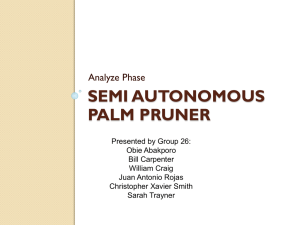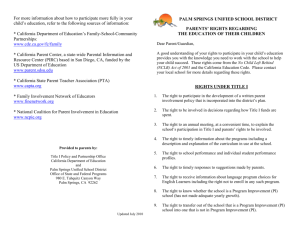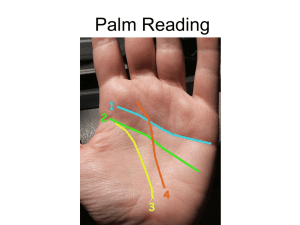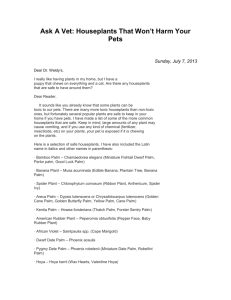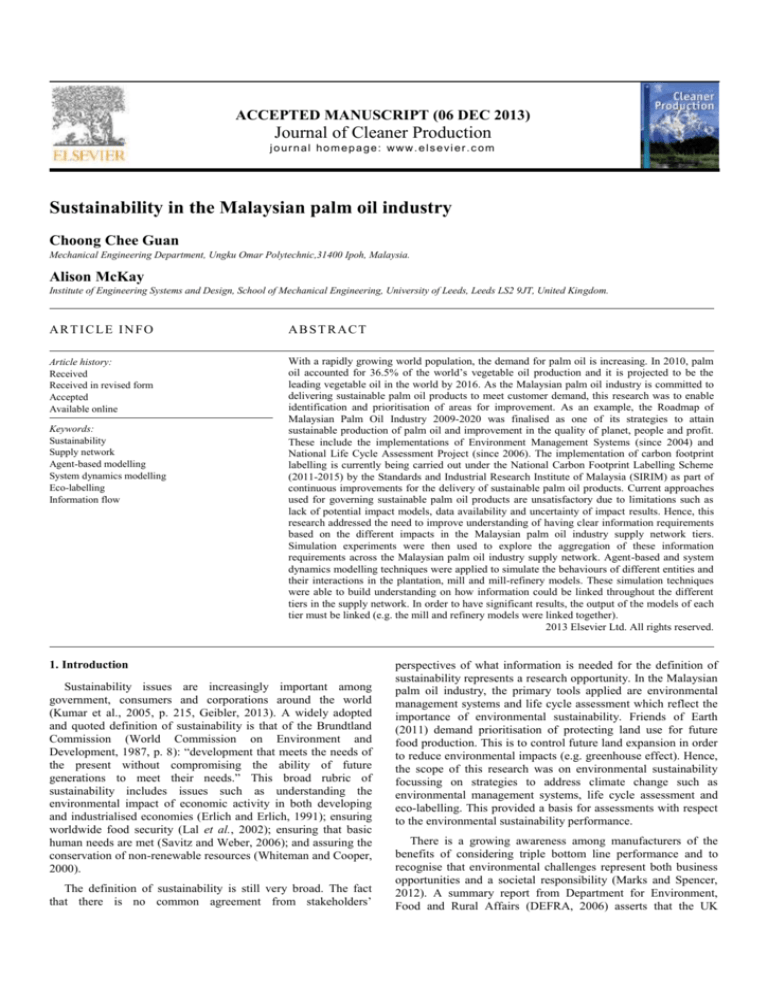
ACCEPTED MANUSCRIPT (06 DEC 2013)
Journal of Cleaner Production
journal homepage: www.elsevier.com
Sustainability in the Malaysian palm oil industry
Choong Chee Guan
Mechanical Engineering Department, Ungku Omar Polytechnic,31400 Ipoh, Malaysia.
Alison McKay
Institute of Engineering Systems and Design, School of Mechanical Engineering, University of Leeds, Leeds LS2 9JT, United Kingdom.
ARTICLE INFO
ABSTRACT
Article history:
Received
Received in revised form
Accepted
Available online
With a rapidly growing world population, the demand for palm oil is increasing. In 2010, palm
oil accounted for 36.5% of the world’s vegetable oil production and it is projected to be the
leading vegetable oil in the world by 2016. As the Malaysian palm oil industry is committed to
delivering sustainable palm oil products to meet customer demand, this research was to enable
identification and prioritisation of areas for improvement. As an example, the Roadmap of
Malaysian Palm Oil Industry 2009-2020 was finalised as one of its strategies to attain
sustainable production of palm oil and improvement in the quality of planet, people and profit.
These include the implementations of Environment Management Systems (since 2004) and
National Life Cycle Assessment Project (since 2006). The implementation of carbon footprint
labelling is currently being carried out under the National Carbon Footprint Labelling Scheme
(2011-2015) by the Standards and Industrial Research Institute of Malaysia (SIRIM) as part of
continuous improvements for the delivery of sustainable palm oil products. Current approaches
used for governing sustainable palm oil products are unsatisfactory due to limitations such as
lack of potential impact models, data availability and uncertainty of impact results. Hence, this
research addressed the need to improve understanding of having clear information requirements
based on the different impacts in the Malaysian palm oil industry supply network tiers.
Simulation experiments were then used to explore the aggregation of these information
requirements across the Malaysian palm oil industry supply network. Agent-based and system
dynamics modelling techniques were applied to simulate the behaviours of different entities and
their interactions in the plantation, mill and mill-refinery models. These simulation techniques
were able to build understanding on how information could be linked throughout the different
tiers in the supply network. In order to have significant results, the output of the models of each
tier must be linked (e.g. the mill and refinery models were linked together).
2013 Elsevier Ltd. All rights reserved.
Keywords:
Sustainability
Supply network
Agent-based modelling
System dynamics modelling
Eco-labelling
Information flow
1. Introduction
Sustainability issues are increasingly important among
government, consumers and corporations around the world
(Kumar et al., 2005, p. 215, Geibler, 2013). A widely adopted
and quoted definition of sustainability is that of the Brundtland
Commission (World Commission on Environment and
Development, 1987, p. 8): “development that meets the needs of
the present without compromising the ability of future
generations to meet their needs.” This broad rubric of
sustainability includes issues such as understanding the
environmental impact of economic activity in both developing
and industrialised economies (Erlich and Erlich, 1991); ensuring
worldwide food security (Lal et al., 2002); ensuring that basic
human needs are met (Savitz and Weber, 2006); and assuring the
conservation of non-renewable resources (Whiteman and Cooper,
2000).
The definition of sustainability is still very broad. The fact
that there is no common agreement from stakeholders’
perspectives of what information is needed for the definition of
sustainability represents a research opportunity. In the Malaysian
palm oil industry, the primary tools applied are environmental
management systems and life cycle assessment which reflect the
importance of environmental sustainability. Friends of Earth
(2011) demand prioritisation of protecting land use for future
food production. This is to control future land expansion in order
to reduce environmental impacts (e.g. greenhouse effect). Hence,
the scope of this research was on environmental sustainability
focussing on strategies to address climate change such as
environmental management systems, life cycle assessment and
eco-labelling. This provided a basis for assessments with respect
to the environmental sustainability performance.
There is a growing awareness among manufacturers of the
benefits of considering triple bottom line performance and to
recognise that environmental challenges represent both business
opportunities and a societal responsibility (Marks and Spencer,
2012). A summary report from Department for Environment,
Food and Rural Affairs (DEFRA, 2006) asserts that the UK
2
Journal of Cleaner Production
government commitment to stimulate the market for more
sustainable goods and services and to shift consumption patterns
of business and consumers is a move to a more sustainable
economy. In 2008, recommendations were also made available
from the International Reference Life Cycle Data System (ILCD,
2008), set up by the European Commission in consultation with
several non-EU countries, industry associations, as well as
scientific experts to facilitate development of formal international
recommendations for life cycle assessment (LCA). Life cycle
assessment is a tool used to assess environmental impacts and
resources used throughout a product’s life cycle (Finnveden et
al., 2009). One of the instruments in supporting life cycle
assessment activities is the life cycle impact assessment. This
instrument is important since increasing environmental impacts
occur in fast growing economies. Life cycle thinking is important
for all countries to avoid shifting of burdens between countries
rather than reducing overall impacts (Finnveden et al., 2009).
Urgent action in many countries is critical for sustainable
development.
The key milestones of current practice implementation and
future action plans of the Malaysian palm oil industry are
illustrated in Fig. 1. These include the implementation of
Environment Management Systems (since 2004) and National
Life Cycle Assessment Project (since 2006). The implementation
of carbon footprint labelling is currently being carried out under
the National Carbon Footprint Labelling Scheme (2011-2015) by
SIRIM as part of continuous improvements for the delivery of
sustainable palm oil products.
In responding to these recommendations, Malaysia was
among the participating representatives involved with the
National Life Cycle Assessment Project since 2006 to support a
national eco-labelling programme and fulfil the requirements of
foreign legislation that demand evidence on the control measures
taken to reduce environmental impact of products and services
throughout their life cycles. For example, in the implementation
of eco-labelling, information of a product needs to be traced back
to the plantation tier (e.g. raw materials) of the supply network.
In this respect, the Standards and Industrial Research Institute of
Malaysia (SIRIM) Berhad is mandated as the implementing
agency by the Government of Malaysia and the Ministry of
Natural Resources and Environment, specifically the
Environmental Conservation and Management Division as the
executive agency; both to work together to ensure delivery of the
national life cycle project outputs by the end of the Ninth
Malaysia Plan (2006-2010). The objectives of the National Life
Cycle Assessment Project are:
As far as food security for palm oil as a source of edible oil is
concerned, there are two main factors that are crucially important
(Lam, 2008). The first factor is that there should be ample supply
to meet the current market demand and also for future expanding
demand. Secondly, the price should be stable and affordable to
the majority of the world’s population. In order to cope with
increased global demand for palm oil, Malaysia’s government is
committed to and has identified environmental, social, and
economic or planet, people and profit challenges. This is
evidenced through various environmental, social and economic
implementation strategies put forward in the national Malaysia
Plans (e.g. National Life Cycle Assessment Project since 2006).
In addition, during the entire period of the 9th Malaysia Plan
(2006-2010), the Roadmap of Malaysian Palm Oil Industry 20092020 (MPOB, 2009) was being finalised as one of its strategies to
attain sustainable production of palm oil and improvement in the
quality of planet, people and profit. Studies of materials flow and
energy balance of fresh fruit bunches (FFB) analyses using
integrated technology also showed improved economic viability
(i.e., integrated technology of biogas and compost production can
provide a good solution for palm oil mills to utilize their byproducts more profitability). This integrated technology such as
using simulation software can be a new solution for a more
sustainable palm oil industry management, while simultaneously
addressing all the three pillars of sustainability of profit, people
and planet (Yoshizak, et al., 2013).
i. To develop a national life cycle inventory database;
ii. To develop a critical mass of local Life Cycle Assessment
practitioners;
iii. To develop eco-labelling criteria documents for the National
Eco-labelling Programme; and
iv. To create awareness among industry and consumer groups on
the importance of Life Cycle Assessment in today’s
manufacturing and procurement practice.
Fig. 1. Key milestones of current practices in Malaysian palm oil
industry
2. Sustainability in the context of Malaysian palm oil industry
Palm oil is the most traded vegetable oil in the world. The
demand for it is expected to continue to increase with rising
consumer income and population growth (Wahid et al., 2007).
Such economic impact in the growth of population for the next
two decades is likely to affect the demand for food items
including palm oil (Basiron and Simeh, 2005). As a result, the
total consumption of world palm oil is expected to be 43 million
tonnes in 2020.
The Malaysian Palm Oil industry supply network is illustrated
in Fig. 2. The palm oil industry supply network can be divided
into four tiers: (1) plantations; (2) mills; (3) refineries; and (4)
manufacturers of different palm-based products. These tiers are
linked together from upstream to downstream. Upstream tiers
comprise of plantations and mill sectors. Plantations sectors are
involved in the seedlings and nursery establishments, plantation
of palm oil plants and the production of fresh fruit bunches.
Whereas, downstream tiers comprise of palm oil refineries, palm
kernel crushers and different manufacturers of palm-based
products such as biodiesel, chemical, cosmetic, food, feeds and
other value-added products. The network structure was used to
inform the definition of the simulation models. These models
were developed based on the identified system boundaries of the
Malaysian palm oil industry supply network. As the key
characteristics of sustainability vary across the different tiers of
the supply network (e.g. such as the impacts of fertilisers and
pesticides used at the seedling stage), different models were
needed for the simulation of different environments. These
simulation models were connected (e.g. the output of plantation
model was used as the input of mill model) in order to
demonstrate the behaviours of different tiers in the supply
network. By doing so, information flows in the supply network
understand sustainability requirements (e.g. eco-labelling), risks
on sustainability issues (e.g. land clearance), uncertainties (e.g.
on the consequences of climate change) and future opportunities
(e.g. improving resource use efficiency from the plantation tier).
Fig. 2. The Malaysian palm oil industry supply network
3. Methodology
tiers can illustrate how productivity in a certain tier affects the
sustainability of other tiers in the supply network.
Extensive research has been carried out by the Malaysian
Palm Oil Board in the area of sustainability initiatives related to
palm oil products for impacts identification along the different
system boundaries across the supply network. Results showed the
way sustainability is defined, varies across different tiers in the
Malaysian palm oil industry supply network. The tiers of
plantation, mill and refinery are mainly referred to as the
Malaysian palm oil industry. Manufacturer, retailer and consumer
tiers vary between different products (manufacturer) and services
(retailer) across different needs (consumer). As for the plantation
tier, the key characteristics of sustainability depend on types of
growers which include large plantations and smallholders.
Plantation growers have the capabilities to achieve demands by
expanding palm trees growth due to land availability and also to
enhance the production of fresh fruit bunches from quality
seedlings. These factors are different to the limited capabilities of
the smallholders who have limited land supply. Hence, the
measurement of sustainability differs between these two different
sizes of organisations. On the other hand, in the mill tier,
sustainability is measured in terms of energy efficiency,
emissions and waste management impacts from the operating
mill plants (Yusoff, 2006). Hence, the measurement of
sustainability depends on the different impacts occurred in each
tier. The knowledge on causal links between standards setting
and induced sustainability effects is an essential requirement for
the successful establishment of sustainability in value chains.
(Geibler, 2013). As an example, operators of the mill plants are
concerned about how to become compliant with sustainability
standards regulated by the government and regulatory agencies.
Meanwhile, manufacturers and retailers have different concerns
due to different requirements from the consumers. The flow of
information and knowledge across tiers is important to
The report published in the International Manufacturing
Professors’ Symposium (2009) stressed the importance of
understanding relationships between industrial and environment
sustainability, customer value and stakeholder requirements in
the design of sustainable industrial systems. Based on this report,
the need to understand potential methods and tool applications
applied by the Malaysian palm oil industry were investigated
through case studies. The enterprise engineering framework
(McKay et. al, 2009) was used to identify improvement options
in the delivery of sustainable palm oil for the Malaysian palm oil
industry in Fig. 3.
Define
Purpose
Strengths and
weaknesses
Agency
Supply network
map
Products &
services
Definition of
sustainable
palm oil
Develop
Deploy
Enterprise
operating
system
Sustainable
palm oil
Fig. 3. The role of enterprise engineering framework
Different enterprise operating systems were used in the
formulation of each case study; this resulted in a holistic view of
the Malaysian palm oil industry in the form of multiple
organisations in focussing different sustainability needs. A
network structure was derived through these case studies using
the enterprise engineering framework to inform the definition of
simulation models. The identified relationships between the
4
Journal of Cleaner Production
different tiers in the supply network were then used to summarise
significant environmental impacts. These environmental impacts
were simulated using different models of plantation, mill and
mill-refinery. The usage of simulation software can help to
analyse, exchange and aggregate information flow based on the
different models from the Malaysian palm oil industry supply
network tiers.
In response to the simulation experiments, the supply network
map of the Malaysian palm oil industry was used for the analysis
of plantation growth; fresh fruit bunches inputs and refinery
outputs together with potential impacts such as energy, waste,
and emission. NetLogo simulation software was used for the
purpose of intervening system behaviours to investigate the
current practices developed by the Malaysian palm oil industry.
Information sharing within the supply network tiers can be
viewed to show interactions between different stakeholders. This
was to build understanding on how sustainability issues can be
potentially intervened using three different models of
verification.
The stock flow diagram for mill model is shown in Fig. 5 and the
formula derived as:Processing Energy = function (processing quantity and
weights, energy per operation)
Waste = function (waste quantity, cost)
Emission = function (corresponding supply network
element, water)
3.1. Simulation using NetLogo
In order to effectively assess performance requirements in the
Malaysian palm oil industry system, agent-based and system
dynamics modelling were used to simulate the behaviours of
different entities and their interactions in the plantation, mill and
mill-refinery models. These simulation techniques were able to
build understanding on how information could be linked
throughout different tiers in the supply network. Agent-based
modelling system was used to capture changes of plantations
growth in the interacting modelling system agents of the supply
network. Meanwhile, system dynamics modelling was used to
simulate the behaviour of different tiers within a product
development scenario and study of the effect of their interactions
in the supply network.
To begin with, the Malaysian palm oil industry supply
network agent-based model was developed by identifying the
agent types and other objects with their attributes. For this study,
the NetLogo simulation was verified as a numerical technique
that takes input data and creates output data based upon a model
of a palm oil supply network system. As an example, a palm oil
plantation may be defined as an agent with inputs of I1
(seedlings) and I2 (land use) in order to produce O1 (fresh fruit
bunches) as output before being sent to the mill. The plantation
model structure is shown in Fig. 4 and the formula derived as:Fresh fruit bunches = function (seedlings, land use)
O1 = f ( I1, I2 )
Fig. 5. Stock flow diagram of mill model
The mill-refinery model was used to understand the process of
refining crude palm oil to be purified as edible oils from the
previous mill model. The stock flow diagram of mill-refinery
model is shown in Fig. 6 and the formula derived as:Processing Energy = function (processing quantity and
weights, energy per operation)
Waste = function (waste quantity, cost)
Emission = function (corresponding supply network
element, air)
3.2. Lists of assumptions
Lists of assumptions were developed in order to simplify
problems, while developing these models in Table 1:Table 1. Lists of assumptions of the simulated models
Plantation Model
add1
add2
I1, seedlings
I2, land use
Plantati
on
Seed
O1,fresh fruit bunches
(FFB)
Land
Palm
Fig. 4. Plantation model structure
The understanding on how supply network interventions
might address sustainability issues in the Malaysian palm oil
industry was also carried out using two different models: mill
model and mill-refinery model. By developing the mill model,
the process of milling of fresh fruit bunches extraction from the
plantation model in the earlier stage can be used to express the
relationships between quantities and the interactions between
fresh fruit bunches as the flow input to produce crude palm oil.
Fruit
seed-add1-growth
Seed-add2-growth
Mill Model
Energy_number
Waste_number
Emission_number
Land
turtles used as agents to complex with seeds
(example: water)
turtles used as agents to complex with seeds
(example: sun)
representative of palm trees seedlings
plantation area of palm trees [approximately 1000 –
6000 ha of land per plantation]
representative of palm trees [1 ha of land = 140 palm
trees]
representative of fresh fruit bunches (FFB) [1 palm
tree = 140 kg FFB]
representative of fertilisers used [scale: 0 to 100]
representative of pesticides used [scale: 0 to 100]
representative of Energy Efficiency [scale: 0.1 to 1.0]
representative of Waste Management [scale: 0.1 to
1.0]
representative of Emission [scale: 0.1 to 1.0]
plantation area of palm trees [approximately 1000 –
6000 ha of land per plantation]
palm
Fruit
representative of palm trees [1 ha of land = 140 palm
trees]
representative of fresh fruit bunches (FFB) [1 palm
tree = 140 kg FFB]
Mill-Refinery Model
Energy_number1
Waste_number1
Emission_number1
Energy_number2
Waste_number2
Emission_number2
land
palm
fruit
representative of Energy Efficiency from Mill Model
[scale: 0.1 to 1.0]
representative of Waste Management from Mill
Model [scale: 0.1 to 1.0]
representative of Emission from Mill Model [scale:
0.1 to 1.0]
representative of Energy Efficiency from Refinery
Model [scale: 0.1 to 1.0]
representative of Waste Management from Refinery
Model [scale: 0.1 to 1.0]
representative of Emission from Refinery Model
[scale: 0.1 to 1.0]
plantation area of palm trees [approximately 1000 –
6000 ha of land per plantation]
representative of palm trees [1 ha of land = 140 palm
trees]
representative of fresh fruit bunches (FFB) [1 palm
tree = 140 kg FFB]
Fig. 6. Stock flow diagram of mill-refinery model
3.3. Programming codes
The code programming of the plantation model was written in
a specific format in the procedures tab commands. The program
has three parts: (1) global variables definitions; (2) setup
procedure was written to initialise the simulation; and (3) go
procedure was written to execute the system repeatedly (in a
loop). The go procedure assigns each agent (turtles) to carry out
the given instruction independently. Agents in NetLogo model
were referred as turtles (refer to List of Assumptions). Typically,
a population of turtles was initialised and procedures were
written that control the behaviour of the turtles. The turtles
represent physical entities whose behaviours result in movements
around the two dimensional world (2D).
As for the mill and mill-refinery models, system dynamics
modelling was used to generate NetLogo variables and
procedures. The code programming of these models was written
in a specific format in the procedures tab commands. These
procedures showed how the models performed based on the
defined equations made. The NetLogo procedures generated from
the models were displayed in the procedures tab of the system
dynamics modelling window. The disadvantage of this system
dynamics modelling was the contents of the procedures tab
cannot be modified and in order to make any modifications, the
models must be edited.
4. Results and discussion
In the beginning of the first three years, when the seeds were
planted, the setting was for no fruit formation. The seed_units
were set at 140 for 1 ha of plantation land with full add1
(example: water) and add2 (example: sun light) units. From the
graph obtained, when the seeds (red) were planted, the usage of
add1 and add2 decreased when the palm trees (green) become
matured. The usage of seed-add1-growth (fertilisers) and seedadd2-growth (pesticides) were set at 25 and 50 respectively. No
fruit was available in this period. The seed_rate and land_rate
eventually became constant.
The plantation model was tested on a full 100% fruits
formation. From the graph below, the same results were obtained.
For example, for 100 ha of plantation land, it produced 14,100
palm trees which can yield up to 1,954,400 kg of fresh fruits.
From the graph obtained (Fig. 7), when the palm trees (green)
started to yield, the seed_rate started to increase due to fruits
formation process. This will eventually come to a constant after a
certain time period. The usage of seed-add1-growth (fertilisers)
and seed-add2-growth (pesticides) were set at 100 and 100
respectively.
The mill model was simulated with no impacts of additional
defined variables such as energy efficiency, waste management
and emission, the production of crude palm oil was seen to
increase constantly until the given time period of yielding of the
palm trees planted of 25 – 30 years. For instance, an increasing
function in the early stage of the mill-out process was affected by
a stock input of the mill-in which was the fresh fruit bunches,
while at a later point in time various resources (fresh fruit
bunches variable) remained idle and induced a higher flow.
When the energy efficiency, waste management and emission
impacts were applied to the mill model, the production of crude
palm oil showed significant reduction in the output value of millout. The plotted graph is shown in Fig. 8.
When the mill-refinery model was simulated with no impacts
of additional defined variables such as energy efficiency, waste
management and emission, the production of crude palm oil was
seen increasing constantly until the given time period of yielding
of the palm trees planted of 25 – 30 years. The RPOolein and
RPOstearin were displayed as two different outputs from the
actual mill-out stock input. The hysteresis shape plotted from the
graph was a reaction function of the mill model transforming into
the refinery stock.
6
Journal of Cleaner Production
Fig. 9. Mill-refinery model result for no impact from additional
defined variables
Fig. 7. Plantation model result for 100% of fruits formation
Fig. 8. Mill model result for no impact from additional defined
variables
For instance, an increasing function in the early stage of the
refining process was affected by a stock input of the milling
model, while at a later point in time various resources (crude
palm oil) remained idle and induced higher flow. The overshoot
graph suggested that the refinery model flow (growth) would
outpace the ability of the mill model to supply crude palm oil,
showing a high demand of refined palm oil. When the energy
efficiency, waste management and emission impacts were
applied to the mill-refinery model, the production of refined palm
oil showed less significant reduction in the output values. The
plotted graph is shown in Fig. 9.
From the simulation results obtained, information flow across
the tiers in the supply network was identified as being important
to the delivery of sustainability requirements used to simulate the
behaviours of different entities and their interactions in the
plantation, mill and mill-refinery models. In order to do so, these
simulation models were connected (e.g. the output of plantation
model was used as the input of mill model) to demonstrate the
behaviours of different tiers in the supply network. For example,
in the implementation of eco-labelling, information of a product
needs to be traced back to the plantation tier (e.g. raw materials)
of the supply network. These simulation experiments have
showed the important elements of aggregating information across
the supply network for the purpose of eco-labelling. Hence,
information flows in the supply network tiers illustrated how
productivity in a certain tier can affect the sustainability of other
tiers in the supply network.
Agent-based modelling and systems dynamic modelling were
proven feasible for modelling and understanding how individual
tiers in the sub systems behave, and how the interaction of these
tiers can lead to continuous improvement of the supply network
performance. There was an opportunity to reduce the impacts of
energy consumption, resulting in wastes and emissions. The
developed models could be populated with real-world data. To
achieve this, the simulation techniques would need to be
developed further with the identification of system boundaries,
simulation parameters related to stakeholder needs, capture of
operating environments, and risks and uncertainties in the
validation of models.
5. Conclusions
The importance of having clear information requirements
based on the different impacts in the supply network tiers can be
used to capture data related triple bottom line performance
indicators in the design of sustainable industrial systems. As an
example, eco-labelling for carbon footprint is part of the control
measures taken to reduce environmental impact of products and
services throughout the life cycle of the Malaysian palm oil
industry supply network. A priority of implementing ecolabelling was due to consumer needs for reliable information to
better inform purchasing decisions. This priority has created
market incentives for manufacturers to develop and supply more
environmentally sound products such as biodiesel, biofuel or
biogas (Silalertruksa et al., 2012 and Reijnders & Huijbregts,
2008). In order to deliver eco-labelling, there is a need to gather
information throughout the different tiers of the Malaysian palm
oil industry supply network. A number of issues need to be
addressed in the establishment of information systems that can be
used to collect sustainability related data. The following were
identified through this research:i. Aligning information perspectives according to the tiers of
the supply network in order to capture different types of data.
For example, information related to land use can be captured
from the plantation tier. Whilst in the milling and refinery
tiers, sustainability issues were referred to energy efficiency,
waste management and emission impacts.
ii. Aggregating data within tiers of the supply network (e.g. in
the milling and refinery plants), to capture data of different
production and process issues such as energy efficiency,
waste management and emission impacts.
iii. Tracing and connecting data through the network. For
example from the end product perspective, such as the
ingredient contents, a jar of peanut butter may consist of palm
oil, peanuts and sugar. From the consumer tier, connectivity
of data through the network from different perspectives is
important for use in eco-labelling. Information gathered from
these different perspectives can be translated into
requirements to achieve traceability in eco-labelling for the
delivery of sustainable palm oil.
iv. Gathering provenance from the information system, e.g.
capturing data and how the data is processed across the
network, can be used to support sustainable supply networks
of other sectors.
Agent-based modelling system was found to be an approach
capable of capturing the changes of plantations growth in the
interacting modelling system agents of the supply network. It was
particularly applicable when agent adaptation and emergence
were important considerations. The system dynamics modelling
was used to simulate the behaviour of different entities within a
product development scenario and the study of the effect of their
interactions in the supply network. Both methods promise to have
far-reaching effects into the future on how businesses can use
computer simulations to support decision-making, government
can use models to make and support policy guidelines, and
researchers can use digital laboratories to further their research.
References
1.
2.
3.
4.
5.
6.
Simulation experiments were based on different tiers in the
Malaysian palm oil industry supply network. The results from
these simulation experiments showed that the output of the
models of each tier must be linked. In order to have significant
results, the mill and refinery models have been linked together.
As such, in the implementation of eco-labelling, information of a
product needs to be traced back to the plantation tier (e.g. raw
materials) of the supply network. Hence, these simulation
experiments have showed the important elements of aggregating
information across the supply network for the purpose of ecolabelling. Further results from the simulation experiments
showed that the behaviours of these models in different tiers can
affect the continuity of information flow across the supply
network. It was found that, in order to study the flow of
information, these models need to be developed from the
upstream to downstream tiers of the Malaysian palm oil industry
supply network.
7.
Information on supply and demands perceived by the
plantation, mill and refinery tiers can be assessed according to the
sequential flow of information in the supply network. For
example, any risks encountered by the tiers that may affect the
supply network performance on product sustainability can be
traced. Hence, by improving traceability and responsiveness, lead
time to demand satisfaction of the consumers can be reduced. In
addition to that, knowledge and information gathered across the
supply network can be disclosed to support sustainability
reporting among practitioners. Interdependencies and information
between tiers are likely to be transformed into knowledge and
capabilities for the purpose of creating value added advantages
across the supply network. These can be further initiated to better
understand the sources of sustainable challenges, issues and
uncertainties from different tiers in the supply network.
13.
8.
9.
10.
11.
12.
14.
15.
16.
17.
18.
Basiron Y. and Simeh MA. (2005). Vision 2020 – The Palm Oil
Phenomenon. Oil Palm Industry Economic Journal, Vol. 5(2).
Department for Environment, Food and Rural Affairs (DEFRA).
(2006). Sustainable Procurement National Action Plan:
Recommendations from the Sustainable Procurement Task Force.
United Kingdom.
Available online at:
http://www.defra.gov.uk/sustainable/government/publications/
procurement-action-plan/index.htm
Erlich, P.R. and Erlich, A.H. (1991). The Population Explosion.
Touchstone. New York.
Finnveden, G., Hauschild, M.Z., Ekvall, T., Guine´e, J., Heijungs,
R., Hellweg, S., Koehler, A., Pennington, D. and Suh, S. (2009).
Recent developments in Life Cycle Assessment. Journal of
Environmental Management, 91. pp. 1-21.
Friends of the Earth. (2011). Sustainability and profit. London,
United Kingdom.
Available online at:
http://www.foe.co.uk/living/articles/sustainability.html
Geibler, J. (2013). Market-based governance for sustainability in
value chains: conditions for successful standard setting in the palm
oil sector. Journal of Cleaner Production, 56. pp. 39-53.
International Manufacturing Professors’ Symposium. (2009).
Towards a sustainable industrial system: accelerating the
contribution of education and research. University of Cambridge
and Cranfield University.
International Reference Life Cycle Data System (ILCD).
Available online at:
http://lct.jrc.ec.europa.eu/eplca/deliverables/internationalreference-life-cycle-data-system-ilcd-handbook
Kumar, V., Haapala, K.R., Rivera, J.L., Hutchins, M.J., Endres,
W.J., Gershenson, J.K., Michalek, D.J. and Sutherland, J.W.
(2005). Infusing Sustainability Principles into
Manufacturing/Mechanical Engineering Curricula. Journal of
Manufacturing Systems Vol 24(3). pp. 215-225.
Lal, R., Hansen, D.O., Uphoff, N. and Slack, S.A. (2002). Food
Security and Environmental Quality in the Developing World.
CRC Press. Boca Raton, Florida.
Lam, M.K., Tan, K.T., Lee, K.T. and Mohamed, A.R. (2008).
Malaysian palm oil: Surviving the food versus fuel dispute for a
sustainable future. Renewable and Sustainable Energy Reviews.
Malaysian Palm Oil Board (MPOB). (2009). Roadmap for the
Malaysian Palm Oil Industry 2009-2020. Selangor, Malaysia.
Marks and Spencer’s Plan A. (2012). Plan A: Doing the right
thing.
Available online at: http://plana.marksandspencer.com
McKay, A., Kundu, S. and Pennington, A.d. (2009). Supply
networks: An approach to designing an extended enterprise.
International Conference on Product Lifecycle Management.
Inderscience Publishing Limited.
Savitz, A.W. and Weber, K. (2006). The Triple Bottom Line.
Jossey-Bass. San Francisco, CA.
Silalertruksa, T., Bonnet, S. and Gheewala, S.H. (2012). Life cycle
costing and externalities of palm oil biodiesel in Thailand. Journal
of Cleaner Production, 28. pp. 225-232.
Reijnders, L. and Huijbregts, M.A.J. (2008). Palm oil and the
emission of carbon-based greenhouse gases. Journal of Cleaner
Production, 16. pp. 477-482.
Wahid, M.B., Lim, W.S. and Simeh, M.A. (2007). Technological
Development and New Growth Areas of the Oil Palm Industry.
Oil Palm Industry Economic Journal. Vol. 7(1).
8
Journal of Cleaner Production
19. WCED. (1987). Our Common Future. Oxford University Press,
Oxford.
20. Whiteman, G. and Cooper, W.H. (2000) Ecological
embeddedness. Academy of Management Journal, Vol. 43 No.6.
pp. 1265-82.
21. Yoshizak, T., Shirai, Y., Hassan, M.A., Baharuddin, A.S., Raja
Abdullah, N.M., Sulaiman, A. and Busu, Z. (2013). Improved
economic viability of integrated biogas energy and compost
production for sustainable palm oil mill management. Journal of
Cleaner Production, 44. pp. 1-7.
22. Yusoff, S. (2006). Renewable energy from palm oil - innovation
on effective utilization of waste. Journal of Cleaner Production,
14. pp. 87-93.




